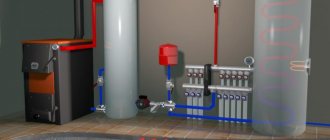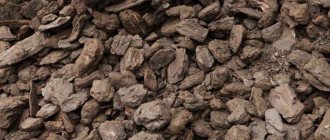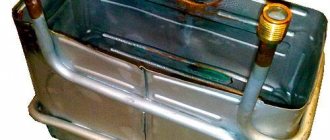If you live in a populated area where the ubiquitous gas pipe has not yet reached, then the problem of heating your own home is more than relevant for you. If you go through all the possible options, excluding blue fuel that is not available to you, then coal will be the undisputed leader. Strange as it may seem, it is coal heating, which was once abandoned due to many side disadvantages of its use, that is making a comeback today.
Coal stoves work on the same principle as classic Russian heating and cooking brick stoves. You can even boil water or cook food on it (read: “Project of a house with stove heating”). But there is one fundamental difference - the air in such devices is heated not due to air convection, but through its uniform heating in several places at once by radiators. Which supplies the coolant, a preheated heating boiler, with a circulation pump.
Traditional stoves, coal and wood, have one unpleasant feature for a city person who is not accustomed to physical labor - they are labor-intensive to maintain:
- You need to constantly add fuel to the stove
- It is often necessary to remove combustion residues from the stove and clean the chimney of soot.
In addition, traditional stoves require constant monitoring due to uneven combustion of fuel. This leads to the likelihood of frequent temperature changes and the need to constantly check instrument readings to prevent accidental overheating of the boiler.
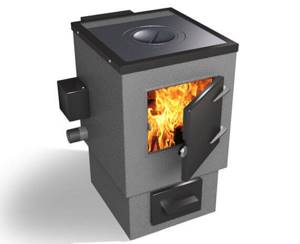
Solid fuel boilers have successfully evolved and are starting to make a comeback! Now they use different combustion principles. If in traditional models a noticeable part of the materials used did not burn completely, resulting in a lot of smoke, soot and ash, then in new models almost all the fuel burns.
New models, thanks to the “efforts” of marketers, are called anything and everything - pyrolysis, top-burning, long-burning coal boilers, and so on. It's not really about the name!
All the different models have common differences from traditional models:
- Versatility. You can burn ANY solid fuel in them almost without leaving a trace - coal, firewood, briquettes, pellets, dry household waste, sawdust, and so on (read: “Fuel briquettes: do-it-yourself production”).
- Long operating time on one fuel load
. The advertisement, of course, exaggerates, claiming that modern top-burning solid fuel boilers can work for weeks from one fill. As practice shows, one portion of fuel lasts from 3 to 8 days. Coal consumption in a solid fuel boiler is directly dependent on the type and quality of coal. High-quality types of coal from low-grade brands with the same volume are distinguished by excellent heat transfer and low waste levels. In second-grade coal, there is generally waste rock, which only wastes the volume of the furnace. - Economical
. Especially if you additionally use free or waste fuel - dry leaves and household waste. On average, solid fuel boilers using new technologies consume 2-3 times less fuel compared to traditional ones. - High heat dissipation
. The fuel burns almost completely due to the high temperature in the firebox. - Easy to use and maintain
. Throwing fuel into the firebox is a task that can be accomplished even by a teenager. And cleaning from ash is a rather rare procedure for modern boilers.
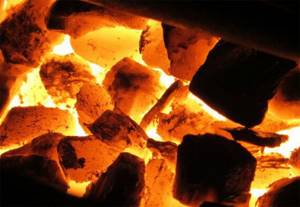
How does modern coal heating work at home?
A simple example to understand how a top-burning boiler differs from a traditional boiler is an ordinary match and a thermometer:
- If you light a match under a thermometer and turn it with the sulfur head down, it will burn quickly and will hardly have time to heat the thermometer (traditional stove).
- If you do the same thing, but place the match with the sulfur head facing up, the match will burn much longer and will greatly heat up the thermometer (top-burning stove).

Heating with coal in a private house works like this:
- Coal is loaded into a voluminous combustion chamber (capacity up to 500 liters).
- The fuel is ignited.
- A lot of air is supplied from above into the combustion chamber through a pipe using a fan to heat the firebox to a temperature that ensures almost complete combustion of the fuel.
- The heat enters the heat exchanger, in which the coolant circulating through the pipes and radiators is constantly heated.
Coal-boiler traditions
Long-burning solid fuel boilers, by the way, were not invented “from scratch.” In the Russian outback, Finnish and Baltic villages, coal stoves of various sizes and designs, made by local craftsmen, are not at all uncommon. Foreign manufacturers simply took a finished model and improved it using modern materials and technologies.
Look at the video for an example of heating a house with a solid fuel boiler using coal:
Many solid fuel boilers can operate on any fuel, but not all. This must be taken into account when choosing a heating unit. Before you buy coal, it is still better to look at the technical passport, which should contain the appropriate brands. If there is no such information, you can use the trial method. Almost all companies selling this type of fuel have coal packaged in bags. It will be necessary to purchase one bag of different grades and fractions, and drown each of them in turn. It is advisable to use the same amount of coal and test indicators such as calorie content, burning time, and ash content. You will read more about these indicators below.
Also from the article you will learn about how to choose coal for heating, about brands of coal and their characteristics.
You can find out the price and buy heating equipment and related products from us. Write, call and come to one of the stores in your city. Delivery throughout the Russian Federation and CIS countries.
Coal for heating
How to calculate coal consumption
Another important point to decide before purchasing is how much coal you will need for the heating season.
It depends on specific factors:
- Type heating, coal and boiler
- Heated area and material of walls, ceiling and floor
- Is there insulation?
- What is the type of windows and the tightness of the doors?
- Severity of winters in the region, duration of the heating season
Thus, well-insulated walls can reduce the need for heat by half. It is also worth noting that more heat is lost through windows than through walls. Even if the double-glazed windows have several chambers and are covered with an energy-saving layer.
In order to determine the approximate amount of coal, you can use 3 calculation methods.
The first way is practical
It does not require calculations and is the simplest. Buy several bags of coal and see how much it takes to maintain a comfortable temperature per day. Based on the result obtained, you can calculate how much is needed per month.
The second method is calculation in buckets for the entire heating period
This is a rough calculation of the amount of coal for heating a private house. We will consider the period from September to April - on average this is 8 months.
Initial data:
- House with an area of 100 m2.
- Bucket with a capacity of 10 l. The average weight of long-flame coal in 1 bucket is about 8 kg.
- The heating season for a private house is 240 days.
Table of approximate coal consumption
| Quantity of coal (per day) | Months |
| 0.5 buckets | September October |
| 3-4 buckets | November-February |
| 0.5 buckets | March, April |
Let's summarize, considering that on average there are 30 days in a month:
- September-October (2*30*0.5) – 30 buckets
- November – December – January – February (4*30*3) – 360 buckets
- March-April (2*30*0.5) – 30 buckets
Total: 30+360+30 = 420 buckets.
Let's convert to tons: 420*8 = 3360 kg
Thus, heating a house of 100 m2 will require about 3.5 tons of coal for the entire heating period.
The third method is calculation in kilograms per day
It is based on taking into account the boiler power, but even here there can be serious errors. We will calculate the consumption per day if the outside temperature is -22°C...-30°C, that is, quite cold.
Initial data:
- The standard formula for boiler power is: per 10 m2 - 1 kW, but this is only when it is very cold outside. Typically, less heat energy is needed. For a house with an area of 1,00 m2, a boiler with a capacity of 10 kW is needed. For a comfortable temperature per day you need 240 kW. From 1 kg of coal you can get 7.5 kW of energy.
- The boiler efficiency varies between 50-90%. This indicator is specified in the technical documentation of the equipment. We will take the average value of 70%.
- The duration of the heating period is about 8 months or 240 days.
Let's make an approximate calculation for a house with an area of 100 m2 per day:
240kW: 7.5 kW = 32 kg coal
It turns out that to heat a house with an area of 100 m2 in severe frosts, you need 32 kg of coal per day.
You can find out the exact consumption only if you know all the factors: ambient temperature, quality of wall insulation, number of windows, and so on. It is also necessary to take into account non-combustible coal residues, that is, impurities. This also increases fuel consumption, so it is better to buy the cleanest possible coal.
Errors in calculations are due to the fact that much depends on weather conditions. Above we looked at a situation where it is very cold outside. But there are not many such days during the entire heating period, so it is only possible to find out approximately how much coal is needed.
After you decide on the type and consumption of coal, the question of storage arises. It is important because its properties depend on the placement conditions. Next, we will tell you how to properly store coal so that it retains its original characteristics for as long as possible.
Types of coal for heating and its labeling
Coal for heating can be:
- brown (has the lowest combustion temperature and is currently not used for heating due to its inefficiency);
- stone;
- anthracite (perfect for powerful boilers).
It is marked using letter designations. The first letter means the grade of coal, the second - its size class.
Letter designation of coal and its types.
| Angle type | Marking |
| Brown | B |
| Stone long-flame (DPK coal) | D |
| Stone gas | G |
| Stone fat | AND |
| Stone coke | TO |
| Stone common | T |
| Anthracite | A |
Coal size class.
| Class designation | Class name | Fraction size, mm |
| TO | Large | 50-100 |
| M | Small | 13-25 |
| ABOUT | Nut | 26-50 |
| P | Slab | More than 100 |
| Sh | Shtyb | No more than 6 |
| WITH | seed | 6-13 |
| R | Private | Not limited |
Coal properties
The qualitative characteristics of coal are important in order to determine whether it can be used for a solid fuel boiler:
- The first parameter that speaks about quality is specific heat of combustion. It displays the amount of heat generated when a unit of fuel is burned. According to the standard, measurement is made in Kcal/kg. Brown coals show the lowest heat transfer (maximum 4500 Kcal/kg). The hottest coals are coking coals (almost 8700 Kcal/kg) and anthracite coals (8600 Kcal/kg). Experts do not recommend using coking fuel in the operation of household units, since it is designed for elevated temperatures, and anthracite must be used with caution.
- The second is the amount of ash residue. And this is the main indicator of quality coal, depending on the volume of non-combustible impurities in the fuel. Few impurities mean little ash, and more heat is released. Ash content is indicated as a percentage. The lower the value, the higher quality the coal. High-grade brands are characterized by an ash residue of up to 25%, low-grade – 40% and higher. The frequency of cleaning the stove directly depends on this parameter. It is logical that the more waste remains after burning coal, the more often the owner will have to clean it. In addition, some of the slag settles on the pipes, which will also need to be cleaned.
- Third - moisture content, which can be surface and internal. In the first case, moisture disappears during air drying, in the second - only during combustion. Thus, the higher the percentage of moisture content in coal, the less the amount of heat required for heating. Instant drying will take a huge amount of energy. Sometimes you can estimate humidity by eye. Freezing of fuel, when small fractions stick together or cake, indicates a high water content.
Features of use
A popular question is which coal is best for heating a home. Experts in this field say - anthracite or coal. Anthracite is able to ensure long-term and uniform combustion of a batch of coal loaded into the boiler, the highest thermal output and a small amount of waste. A popular type of coal, which is intended for combustion in low-power boilers, is considered to be long-flame ordinary coal, seed, nut.
In recent years, anthracite has become increasingly popular due to its low sulfur content (up to 1%) and ash (up to 10%). Due to the low sulfur content, the combustion products formed during the combustion of anthracite contain less sulfur dioxide. In addition to benefits for the environment, this has a beneficial effect on the service life of boiler parts and chimney pipes, which are exposed to the least amount of sulfurous and sulfuric acid, which appear as a result of the interaction of sulfur and water vapor.
If you decide to purchase coal for a heating boiler, take note that the amount of fuel will directly depend on its quality characteristics. Therefore, make a purchase only from manufacturers who have the appropriate quality documents.
Brown coal
This natural material is a transitional link between peat and coal. The quality indicators of brown coal are very low. High humidity of the material (up to 40%) makes it difficult to obtain a high combustion temperature. The structure of the material is not dense, so after drying in the open air, the coal can turn into powder. Carbon content is 50–77%.
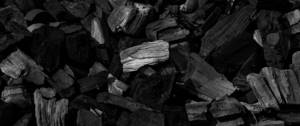
Brown coal can be divided into several varieties:
- ordinary coal has dense pieces with a matte surface, brown in color;
- the earthy material has a loose structure, and is very easily ground into powder;
- resinous coal, dark brown in color, has a dense structure, with a shiny fracture surface;
- Peat coal contains a lot of impurities.
Brown coal is most often used for home heating in small private boiler houses. Brown coal is marked with the letter B.
Advantages of heating a house with coal
- Coal is mined on Russian territory, and prices do not fluctuate.
- To use this fuel, you do not need to install special gas pipelines, as for gas heating.
- Its price is relatively low compared to liquid fuel or gas.
- Easy to transport, it does not require special storage conditions.
- Heating with coal is beneficial because it retains heat during smoldering. Thus, the heated air in the room will remain warm for a long time.
- The good thermal output of coal makes it possible to use it in small batches in order to maintain a comfortable temperature even in severe frosts.
Which is better, coal or gas?
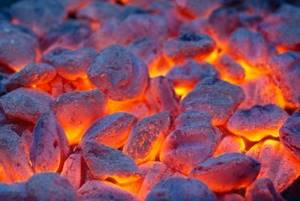
It is generally accepted that the most profitable option for heating is main gas.
However, having learned the cost of supply and connection, many residents are looking for alternative heating options. It is better to compare these types of fuel according to three criteria:
- Energy. When burning 1 m 3 (0.62 kg) of natural gas, you will receive 9.45 kW/h of heat without taking into account the boiler efficiency. A kilogram of anthracite will give 7.16 kW/h.
- Economic. Tariffs for the population for gas supplies are taken into account, as well as the cost of transporting coal and the efficiency of boilers.
- Ease of use. In all cases, a chimney and ventilation will be required. Storage of coal fuel requires space; it will have to be stored manually, while gas is supplied through a pipeline.
Reference. If the house is already connected to the gas main, then you don’t have to look for a more profitable heating method. If there is no connection, the best option is coal boilers operating in automatic mode.
Preparing the stove and burning coal
Before starting kindling with coal, it is necessary to inspect the stove for serviceability and carry out some preparatory procedures. This is especially important for dachas, where the owners are not present often and the stove remains idle for a long time:
- You need to carefully inspect the stove for cracks in the masonry. If they are, then smoke and carbon monoxide may enter the house. As temperatures rise, cracks can become larger and cause even more damage to the masonry. Cracks must be sealed with a mixture of clay and sand.
- It is worth inspecting the chimney (attic and roof) for the presence of whitewash.
- It is not recommended to leave flammable and easily flammable objects closer than 1.5 meters from the hot walls of the stove. And also place dried firewood close to the stove.
- With constant use, it is necessary to clean the pipe 2-3 times a month.
- The stove must be cleaned before lighting. Slag and ash are poured with water and scooped out with a poker, removing them from a specially designated area. The outside of the stove must be cleaned of dust with a dry cloth, otherwise there will be an unpleasant smell in the room.
- Do not use pieces of bitumen, construction and agricultural waste, or plastic for kindling.
- It is not recommended to open the vent and the stove door at the same time.
- To prevent the stove from overheating, it is heated a couple of times a day for no more than two hours.
- Coal is used dry, medium size. It is cleaned of dust and dried.
If the coal is wet, then as the temperature rises, the water will turn into steam, and then into condensate, which will settle on the pipe walls, mix with soot and cool the heating device.
Under no circumstances should you use kerosene, gasoline or similar flammable liquids for kindling.
Do not leave the stove unattended during heating periods. Especially if there are children or animals in the room.
Now, as for kindling with coal:
- The first thing you need to do is clean the stove from soot and ash and prepare the coal.
- A layer of crumpled newspapers or paper is placed on the bottom of the combustion chamber, and a layer of small wood chips is placed on top.
- Small dried logs, for example birch, are placed on the wood chips. For better combustion, the firewood is laid in a “well” or “hut” and leaves space between them for good air circulation.
- You can set fire to newspapers with regular matches, as well as with a special spray can.
- The oven door is closed. The blower is opened. With its help, the strength of the flame is regulated. Accordingly, the more air enters, the more intense the fire in the stove.
- When the logs burn, a layer of hot coals appears. A layer of fine (about 15 cm) coal is poured into the stove.
- If the furnace door opens, then the vent should be closed.
- After good combustion, the coal must be added up to 60 cm (coarse fraction).
At the moment of flaring, the coals need to be stirred a little to improve air circulation and prevent the mass from baking.
Coal is added through the combustion door or through the shifted burners of a metal stove (this option is considered more convenient and safe).
Coal dust that may remain after using coal should not be thrown away in a hurry. It can be used for heating.
It is not difficult to purchase coal or anthracite in Russia - you can purchase it either in one small bag, or in large quantities at once, placing an order for delivery directly to the storage location.
Kindling the stove
After carrying out the preparatory steps, you can proceed directly to lighting the stove. Remember that it is strictly prohibited to use flammable liquids and materials to ignite heating oil.
You can properly light the stove in the following order:
- Sheets of crumpled dry paper or newspaper are placed at the bottom of the combustion chamber. Small chips of wood are laid on top. Next, small wooden logs are added, which are best folded in the form of a hut or a well.
- Having ignited the paper, the firebox door must be closed and the ash pan opened.
- After the firewood has completely burned out, fine coal is placed on the smoldering remains in a layer 15 cm thick. To reduce coal caking, it is better to mix this mass with a poker.
- When the fine fraction burns well, coarse coal is added to the furnace for heating.
- The combustion door closes and the ash chamber damper regulates the required air flow for efficient combustion.
To increase the functionality of oven equipment, you can install special stoves for cooking.
What types of coal are there?
The grade of coal indicates the age of this rock. The youngest is brown coal, followed by hard coal and then anthracite. The depth of the deposit increases as it ages, and the quality of the fuel increases.
Brown coal (1B, 2B, 3B)
Brown is a hint of color. It is much lighter than just black.
Brown coal is easy to mine because it lies on the surface. Its structure is less dense and contains moisture (30-40%).
This type of fuel burns with the formation of a large amount of slag. Since moisture enters the structure, combustion is accompanied by the release of steam and soot. The cost of this type of coal is the lowest possible. Brown coal is mined in Europe.
Stone coals
Hard coals come in the following grades: Gas (G); Long flame (D); Coke (K); Fat (F); Lean-sintering (OS); Skinny (T); Low-caking (SS); Anthracites (A).
Bituminous or hard coal
This rock is found throughout the globe and is more difficult to mine than brown coal because this type of fuel lies at depth. Due to the fact that coal has been subjected to great pressure from layers of earth, it is denser than brown coal and contains less moisture. It burns beautifully, burning almost completely and releasing a large amount of heat.
The cost is more expensive than brown coal.




